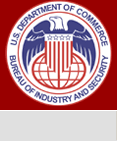Where Industry and Security Intersect
What's New | Sitemap | Search


OPEN SESSION
1. The ISTAC meeting opened with introductions and solicitation of comments from the public. There were no comments from the public. Approximately 30 people were in attendance.
2. Elissa Huffstetler of the Information Assurance division of SPAWAR welcomed the ISTAC to SPAWAR and provided an informational overview of divisional programs and activities.
3. Kathleen Gebeau of Qualcomm and Karen Murphy of Applied Materials provided an overview of the upcoming export control/trade compliance workshop that will be held March 23, 2007 at Semicon China. There is increasing interest in this workshop, both in terms of number of participants and in subject matter. The ISTAC will seek to have a report of this workshop presented at our April meeting.
4. David Kirk of nVidia provided an informational overview of graphics processor technology. Key points are that: 1) Pixel rates, polygon rates and vector rates are all now much larger than what is needed to achieve desired graphics quality; 2) Effort is begin focused on processing to do better computations and implement better models (e.g., light reflection models); 3) Graphics processors currently implement single-precision floating point, but that they will begin to implement double-precision floating point as early as February 2008; 4) The key driver for the transition to double-precision floating point in graphics processors will be a decision by Microsoft to use double-precision in DirectX; 5) There are unresolved issues of how GPUs with double-precision will be accounted for in APP calculations. Further investigation/debate will be needed, and nVidia indicated a desire to play a role in those investigations/debates.
5. Michael Angelo of NetIQ presented a proposal for a new Decontrol Note in 5A002 that would exclude from control hardware/software for performance monitoring & management. The rationale for this proposal is that performance monitoring & management is limited to a finite set of requests/tasks (all centered around retrieving operating system or application specific information), and that all returned messages are similarly in a predefined, fixed format (that is, there is no capability to encrypt an arbitrary message). It was suggested that the proposal would benefit from inclusion of examples of products that would be affected (decontrolled) and also from a discussion of the encryption strength that is typically used in these products. Michael agreed to consider these questions and to rewrite the proposal accordingly.
6. Michael Angelo continued with a presentation on encrypted USB flash drives. These devices are mass-market items (uncontrolled and untrackable) and provide strong encryption. Additionally, their large storage capacity raises the possibility of transferring large amounts of encrypted data. Michael suggests that the implications of this relative to the Cat 5 Pt 2 encryption controls are not yet understood, and that they may provide rationale for changes to those controls. It was agreed that further study is required.
7. Henry Brandt of IBM presented an argument for deletion of entry 4D003.a from the Wassenaar dual-use list. The key point of the argument is that open-source operating system code has changed the considerations of 4D003.a, rendering it obsolete and uncontrollable. It was agreed that Henry will draft a proposal for consideration as USG prepares for the 2008 Wassenaar list review.
8. Earl Joseph of IDC made an informational presentation of the HPC market in Asia, with particular emphasis on China. Key points were: 1) China is more aggressive than other Asian countries in efforts to build their own (indigenous) HPC equipment; 2) The indigenous Chinese equipment is mostly x86-based, which insulates them from export-control measures; 3) The installed base of HPCs in China is growing rapidly; 4) China has no legacy software that requires backwards compatibility; thus, they have more freedom in hardware development efforts than might be expected.
9. Bernie Kritzer joined the meeting by telephone and provided a BIS update. Key points were: 1) The Comprehensive CCL review that the TACs have been asked to undertake is of particular interest to BIS; 2) The first DEAC meeting (in which interested industry members were invited to speak) was instructive and BIS plans to hold more such meetings. Further, BIS invited interested parties to raise appropriate technical questions and issues to the DEAC. 3) A revised draft of the China Military End-Use Rule is being prepared, in response to comments that have been received from the public. No estimate was provided as to when the revised draft would be available to the TACs.
10. John Noble of Agilent made a presentation on 3A002 instrumentation issues. Key points were: 1) How the frequency switching time should be interpreted for arbitrary waveform generators, and 2) Possible future changes to the 3A002 control language for signal analyzers, network analyzers, and phase noise of signal generators. Industry will continue to review the question of how to interpret and measure the frequency switching time for arbitrary waveform generators, with the goal of presenting a white paper on the topic at the April ISTAC meeting.
The open session was adjourned.